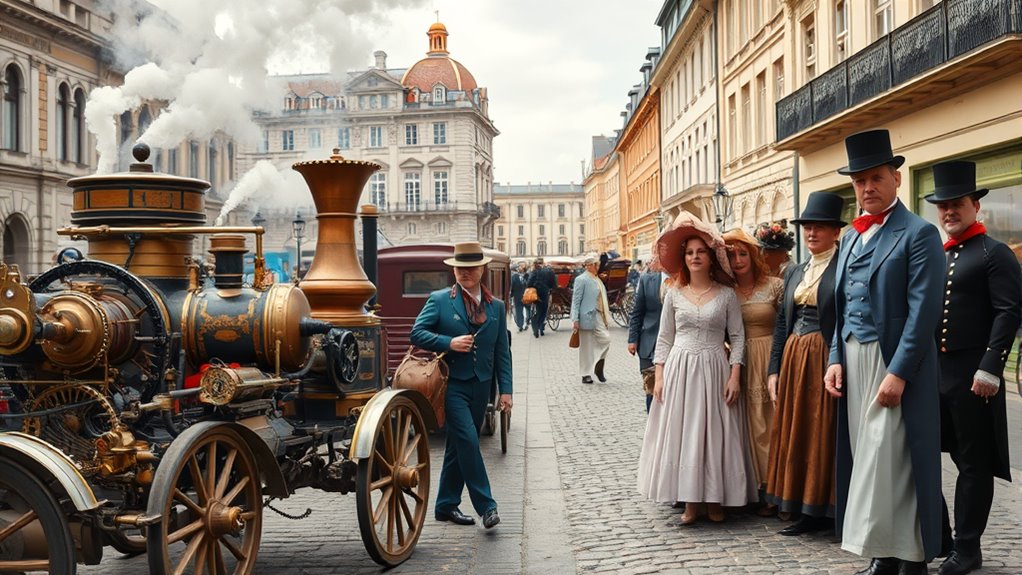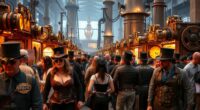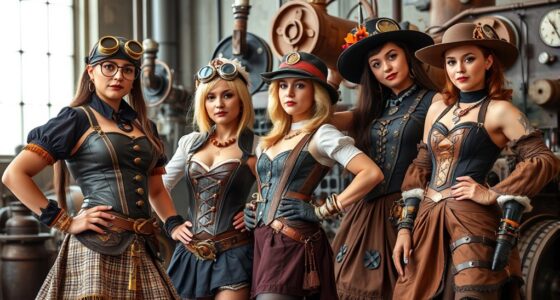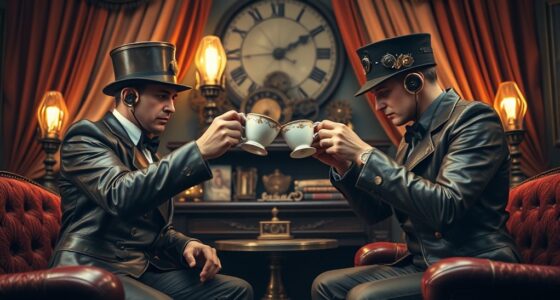In exploring steampunk versus historical fiction, you’ll see both blur fact and fantasy, but in different ways. Steampunk reimagines history with imaginative, anachronistic inventions, creating an alternative world that combines Victorian aesthetics with futuristic technology. Historical fiction, meanwhile, sticks closer to real events and settings, though it may incorporate subtle “what-ifs.” If you want to understand how these genres challenge perceptions of the past and blend fact with fantasy, there’s more to learn ahead.
Key Takeaways
- Steampunk blends Victorian-era settings with fantastical inventions, creating an alternative history that blurs fact and fantasy.
- Historical fiction faithfully depicts real events and settings, aiming for accuracy while occasionally exploring subtle “what-ifs.”
- Both genres incorporate imaginative elements, but steampunk emphasizes technological innovation and playful reimagining.
- Historical fiction maintains plausibility and authenticity, avoiding overtly anachronistic technology, unlike steampunk’s creative liberties.
- The genres challenge perceptions of reality by merging factual history with speculative and fantastical elements.

Steampunk and historical fiction are two popular genres that often attract fans of imaginative storytelling and rich settings. While both genres explore into the past, they do so with distinct approaches. Steampunk blends Victorian-era aesthetics with anachronistic technology, creating a unique fusion of history and innovation. You might imagine airships floating over London or clockwork automata performing daily tasks, all inspired by a different timeline where steam-powered machines advanced beyond their historical limits. This genre thrives on alternative history, where the course of events has shifted, allowing writers and readers to explore what might have been if technological progress took a different path. As a result, steampunk offers a playful reimagining of history, blending fact with fantasy to craft worlds that are both familiar and fantastical.
In contrast, traditional historical fiction aims for accuracy and authenticity, grounding its narratives in real events, cultures, and personalities. When you read historical fiction, you’re transported to a specific time and place, experiencing life as it was, with meticulous attention to detail. The genre seeks to preserve the integrity of history, often relying on extensive research to portray historical figures, settings, and customs faithfully. While both genres can include imaginative elements, historical fiction generally stays within the boundaries of what is known or plausible, resisting the temptation to alter key facts or introduce anachronistic technology that would feel out of place for the era. The focus is on storytelling that respects the past, even if some creative liberties are taken to enhance narrative flow.
Both genres, however, blur the lines between fact and fantasy in their own ways. Steampunk, with its emphasis on anachronistic technology, often reimagines history by inserting advanced machinery or futuristic inventions into the Victorian world, effectively rewriting the timeline. This alternative history allows you to see familiar settings through a lens of innovation that never actually existed, creating worlds where history is a springboard for invention and speculation. Meanwhile, historical fiction might incorporate subtle what-ifs—like imagining how a different outcome in a battle could have changed history—without overtly altering the core facts. Both genres challenge your perception of reality, encouraging you to think about how history and imagination intertwine, pushing the boundaries of what you believe is possible within the past.
Frequently Asked Questions
How Do Steampunk and Historical Fiction Influence Modern Technology?
You influence modern technology by exploring Victorian innovations and alternative histories through steampunk and historical fiction. These genres inspire inventors and designers to reimagine gadgets and aesthetic concepts, blending past and future. By imagining worlds where Victorian-era tech evolved differently, you spark creativity that can lead to real-world innovations. This fusion of fact and fantasy pushes boundaries, encouraging technological advancements inspired by historical ideas reinterpreted through a modern lens.
Are There Any Crossover Genres Combining Steampunk and Historical Fiction?
You’ll find crossover genres blending steampunk and historical fiction, especially in alternate history and retro-futurism. These genres let you imagine “what if” scenarios, merging Victorian aesthetics with speculative technology. They create a fascinating mix where history and fantasy collide, allowing you to explore worlds that challenge traditional timelines. As the saying goes, “The sky’s the limit,” and these genres push those boundaries, offering rich, inventive storytelling experiences.
What Are Common Misconceptions About Steampunk and Historical Fiction?
You might think steampunk and historical fiction always prioritize historical accuracy, but that’s a misconception. Both genres often blend fact and fantasy, allowing for creative genre blending that enriches storytelling. People assume these genres strictly follow real history, yet they frequently incorporate imaginative elements to enhance the narrative. Embracing the mix of fact and fantasy creates a more engaging, unique experience, showing that historical accuracy isn’t always the main goal.
How Do Authors Balance Fact and Fantasy in These Genres?
Did you know that 75% of authors in these genres prioritize creative liberties over strict historical accuracy? To balance fact and fantasy, you should carefully weave historical details with imaginative elements, ensuring authenticity while allowing room for inventive storytelling. This approach keeps readers engaged, enriching the narrative without sacrificing credibility. By blending accurate settings with creative twists, you can craft compelling stories that honor history while embracing fantasy.
Can Readers Easily Differentiate Between Steampunk and Historical Fiction Themes?
You can often tell apart steampunk and historical fiction through their visual distinctions, like Victorian-inspired gadgets versus authentic period settings. While genre overlap exists, steampunk features fantastical inventions and anachronistic details that set it apart from pure historical fiction. Paying attention to these visual cues helps you differentiate between the genres, even when they share themes or settings, making it easier to enjoy each for its unique blend of fact and fantasy.
Conclusion
So, whether you’re tinkering with Victorian gadgets or reimagining ancient tales, remember: both genres love to bend the truth just enough to keep you guessing. Steampunk and historical fiction dance on the fine line between fact and fantasy, making history as unpredictable as a clockwork contraption gone awry. Embrace the chaos, enjoy the wild rides, and don’t be surprised if your history book suddenly starts to look more like a mad inventor’s journal.









